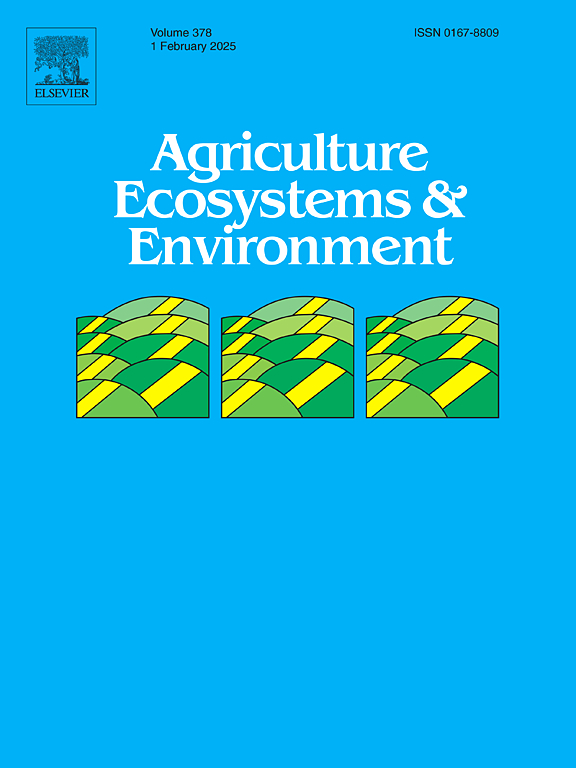Opposite effect on soil organic carbon between grain and non-grain crops: Evidence from Main Grain Land, China
IF 6
1区 农林科学
Q1 AGRICULTURE, MULTIDISCIPLINARY
引用次数: 0
Abstract
The soil organic carbon (SOC) content of cropland affects global food production and is crucial for agricultural carbon reduction. The SOC response to long-term changes in main grain land (MGL) likely differs from non-MGL cropland. We constructed a quantitative indicator system for the MGL planting pattern to reveal the relationship between MGL use change and SOC. We produced an MGL dataset for China from 1985 to 2020 based on the existing MGL distribution data and available Landsat images and analyzed the heterogeneity of SOC under different MGLs using two SOC datasets. Time series change detection explained the interaction between planting patterns and SOC. Different MGLs exhibited considerable heterogeneity in SOC. The single rice area with the highest SOC was twice (31.62 g/kg) that of the wheat and maize areas. SOC showed an opposite trend in MGL and non-MGL with increased planting intensity. Soil SOC content affected the expansion decisions of farmers in cropland and MGL. Areas with a high SOC were developed into MGL by farmers early. MGL consumed more SOC and had a stronger urgency for fallow cultivation than non-MGL. The planting intensity of MGL more than the inflection threshold (about 15 years) decreased shallow SOC (0–15 cm), decreasing below the initial value after more than 30 years. Currently, 62.08 % of MGL in China causes a decrease in SOC, with an urgent need for a fallow MGL of 27.38 Mha. Theoretical guidance for optimizing crop planting patterns to ensure food security and reduce agricultural carbon emissions was provided.
粮食作物和非粮食作物对土壤有机碳的影响截然相反:中国主要粮田的证据
耕地的土壤有机碳(SOC)含量影响着全球粮食产量,对农业碳减排至关重要。主要粮田(MGL)的土壤有机碳对长期变化的响应可能不同于非主要粮田耕地。我们为主要粮田种植模式构建了一个定量指标体系,以揭示主要粮田用途变化与 SOC 之间的关系。我们基于现有的耕地分布数据和现有的大地遥感卫星图像,建立了中国从 1985 年到 2020 年的耕地数据集,并利用两个 SOC 数据集分析了不同耕地下 SOC 的异质性。时间序列变化检测解释了种植模式与 SOC 之间的相互作用。不同的地方政府土地在 SOC 方面表现出相当大的异质性。SOC 最高的单一水稻区是小麦和玉米区的两倍(31.62 克/千克)。随着种植强度的增加,主要种植区和非主要种植区的 SOC 呈相反趋势。土壤 SOC 含量影响了农民扩大耕地和套作的决定。SOC 含量高的地区很早就被农民开发成了 MGL。与非套作地相比,套作地消耗的 SOC 更多,休耕的紧迫性也更强。多元土地的种植强度超过拐点临界值(约 15 年)后,浅层 SOC(0-15 厘米)下降,30 多年后降至初始值以下。目前,中国 62.08% 的间作套种导致 SOC 下降,急需 2 738 万公顷的间作套种休耕。这为优化作物种植模式以确保粮食安全和减少农业碳排放提供了理论指导。
本文章由计算机程序翻译,如有差异,请以英文原文为准。
求助全文
约1分钟内获得全文
求助全文
来源期刊

Agriculture, Ecosystems & Environment
环境科学-环境科学
CiteScore
11.70
自引率
9.10%
发文量
392
审稿时长
26 days
期刊介绍:
Agriculture, Ecosystems and Environment publishes scientific articles dealing with the interface between agroecosystems and the natural environment, specifically how agriculture influences the environment and how changes in that environment impact agroecosystems. Preference is given to papers from experimental and observational research at the field, system or landscape level, from studies that enhance our understanding of processes using data-based biophysical modelling, and papers that bridge scientific disciplines and integrate knowledge. All papers should be placed in an international or wide comparative context.
 求助内容:
求助内容: 应助结果提醒方式:
应助结果提醒方式:


